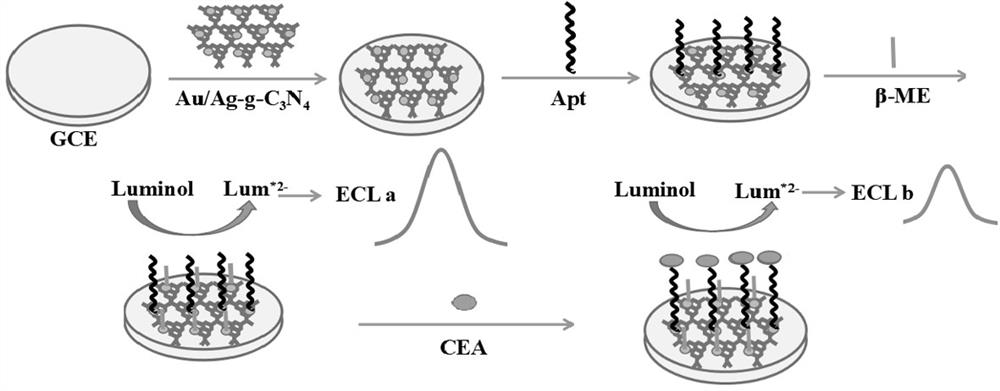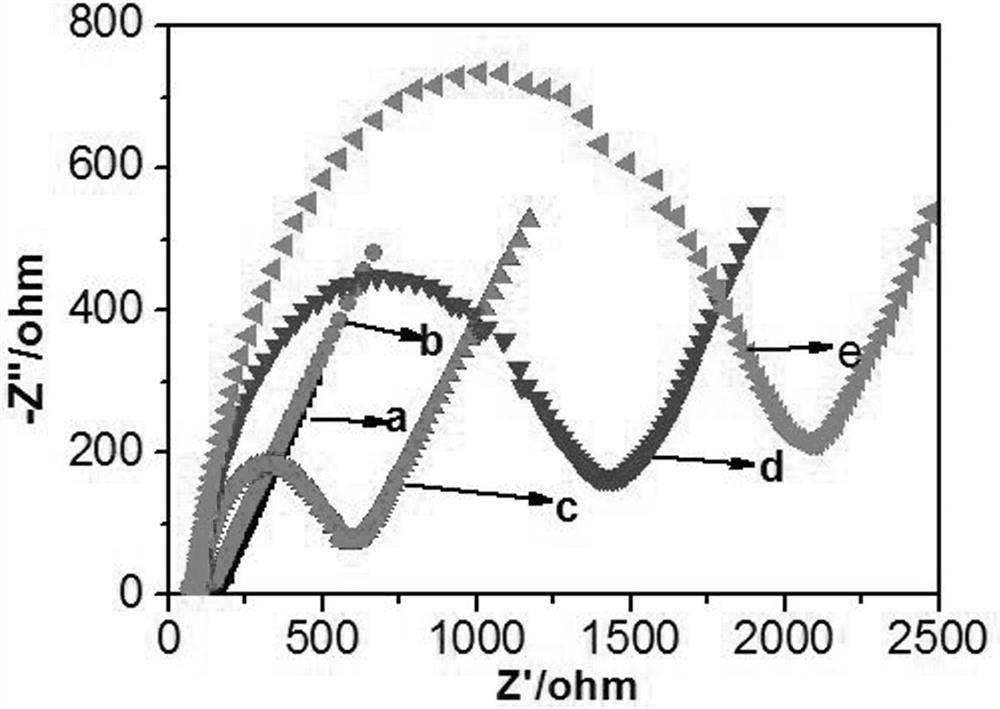A label-free electrochemiluminescent aptasensor for detecting carcinoembryonic antigen and its preparation method and use method
An aptamer sensor and carcinoembryonic antigen technology, applied in scientific instruments, instruments, measuring devices, etc., can solve the problems of easy inactivation of biological enzymes, narrow linear range, etc., and achieve good specificity, wide detection range, and high sensitivity Effect
- Summary
- Abstract
- Description
- Claims
- Application Information
AI Technical Summary
Problems solved by technology
Method used
Image
Examples
Embodiment 1
[0044] A method for preparing a label-free electrochemiluminescence aptasensor for detecting carcinoembryonic antigen, the steps are as follows:
[0045] (1) Au-Ag / g-C 3 N 4 Preparation of nanocomposites
[0046] Put 20.0 g of urea into an alumina crucible, place it in a muffle furnace, raise the temperature to 550 °C at a rate of 15 °C / min, and maintain this temperature for 2 h. Naturally cooled to room temperature to obtain a yellow solid, after grinding to obtain g-C 3 N 4 Nanosheets.
[0047] Add 5 mg of g-C to a 150 mL three-necked flask equipped with a reflux condenser 3 N 4 Nanosheets, homogeneous g-C was obtained under magnetic stirring 3 N 4 Add 50 μL of 0.1 M chloroauric acid solution and 40 μL of 0.1 M silver nitrate solution to the suspension, heat to boiling and quickly add a mixed solution of 20 μL of 0.1 mM sodium borohydride and 250 μL of 0.5 mM sodium citrate, and continue heating After reflux for 15 min, naturally cool to room temperature under stirr...
Embodiment 2
[0054] A method for preparing a label-free electrochemiluminescence aptasensor for detecting carcinoembryonic antigen, the steps are as follows:
[0055] (1) Au-Ag / g-C 3 N 4 Preparation of nanocomposites
[0056] Put 20.0 g of urea into an alumina crucible, place it in a muffle furnace, raise the temperature to 550 °C at a rate of 15 °C / min, and maintain this temperature for 2 h. Naturally cooled to room temperature to obtain a yellow solid, after grinding to obtain g-C 3 N 4 Nanosheets.
[0057] Add 5 mg of g-C to a 150 mL three-necked flask equipped with a reflux condenser 3 N 4 Nanosheets, homogeneous g-C was obtained under magnetic stirring 3 N 4 After the suspension, add 75 μL of 0.1 M chloroauric acid solution and 50 μL of 0.1 M silver nitrate solution, heat to boiling and quickly add 50 μL of 0.1 mM sodium borohydride and 225 μL of 0.5 mM sodium citrate mixed solution, continue heating After reflux for 15 min, naturally cool to room temperature under stirring, ...
Embodiment 3
[0064] A method for preparing a label-free electrochemiluminescence aptasensor for detecting carcinoembryonic antigen, the steps are as follows:
[0065] (1) Au-Ag / g-C 3 N 4 Preparation of nanocomposites
[0066] Put 20.0 g of urea into an alumina crucible, place it in a muffle furnace, raise the temperature to 550 °C at a rate of 15 °C / min, and maintain this temperature for 2 h. Naturally cooled to room temperature to obtain a yellow solid, after grinding to obtain g-C 3 N 4 Nanosheets.
[0067] Add 5 mg of g-C to a 150 mL three-necked flask equipped with a reflux condenser 3 N 4 Nanosheets, homogeneous g-C was obtained under magnetic stirring 3 N 4 After the suspension, add 60 μL of 0.1 M chloroauric acid solution and 30 μL of 0.1 M silver nitrate solution, after heating to boiling, quickly add a mixed solution of 32 μL of 0.1 mM sodium borohydride and 275 μL of 0.5 mM sodium citrate, and continue heating After reflux for 15 min, naturally cool to room temperature u...
PUM
| Property | Measurement | Unit |
|---|---|---|
| diameter | aaaaa | aaaaa |
| particle diameter | aaaaa | aaaaa |
Abstract
Description
Claims
Application Information
 Login to View More
Login to View More - R&D
- Intellectual Property
- Life Sciences
- Materials
- Tech Scout
- Unparalleled Data Quality
- Higher Quality Content
- 60% Fewer Hallucinations
Browse by: Latest US Patents, China's latest patents, Technical Efficacy Thesaurus, Application Domain, Technology Topic, Popular Technical Reports.
© 2025 PatSnap. All rights reserved.Legal|Privacy policy|Modern Slavery Act Transparency Statement|Sitemap|About US| Contact US: help@patsnap.com



